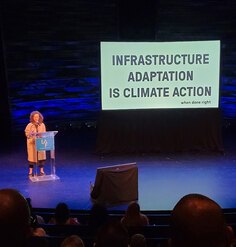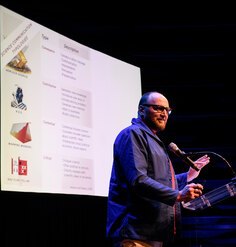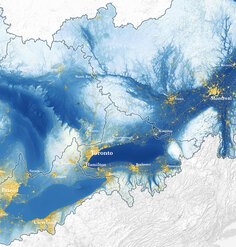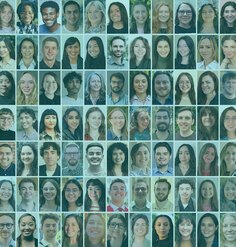LAF Fellowship Spotlight: Immaterial Outcomes
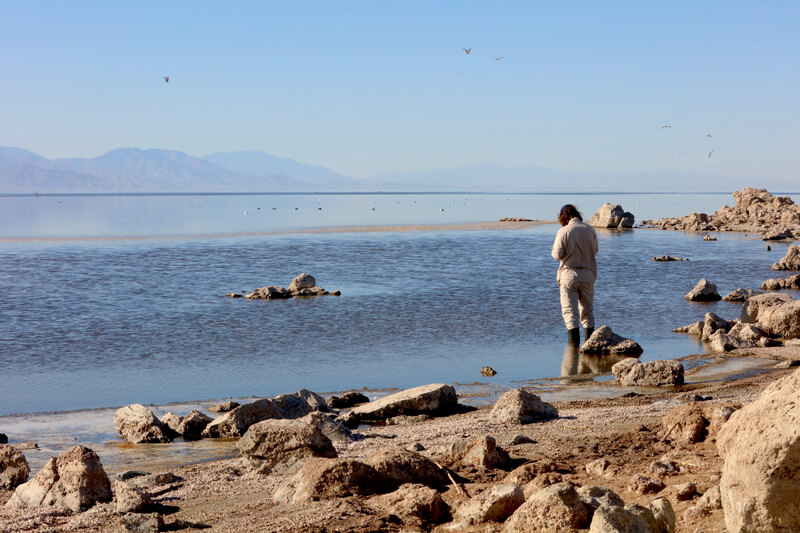
Members of the 2019-2020 cohort of the LAF Fellowship for Innovation and Leadership have been exploring big ideas and refining their proposed projects for nearly a year. The Fellows will present the culmination of their work at LAF’s Innovation + Leadership Symposium in the spring of 2020. In the meantime, LAF is profiling each Fellow to share more about their progress and personal journeys.
Hans Baumann, an independently practicing landscape architect, is using the LAF Fellowship for Innovation and Leadership to tackle an evolving series of questions. What began as an inquiry on the relationship between ecological processes and cultural systems—between a deteriorating California lake and the indigenous tribe that once depended on it—has morphed into a practicum in immaterial outcomes. Having begun coordination roughly a year before applying for the LAF Fellowship, Hans now touts the ability to “forget what the project was and allow it to become what it needs to be” as a necessary shift in the design process.
What the project “needs to be,” Hans understands, must come from the native Torres-Martinez Cahuilla tribe, who possess a relationship with the Salton Sea Basin that spans countless generations. As Hans investigated the ecological degradation that has taken place at this site, he found it “puzzling and problematic” that the narrative largely ignored their voice.
Beverlyann Cedeno, Grant Writer and Special Project Lead, filled in the gaps. She explained that her tie to the water had been almost nonexistent before she and Hans began working on the project. Her father, a tribal elder, passed down stories of a time when the water provided a source of food and recreation—a far cry from the public health hazard that Beverlyann has known in her lifetime. Over the years, fluctuating inflows, increasing salinity, and contamination from agricultural and other runoff, have led to algal blooms, fish die-offs, and a shrinking lake which, exacerbated by climate change, is expected to lose more than one-third of its volume by 2030.
Hans initially sought to craft a landscape installation that would provide a space for reflection and interaction in a barren site. Along the way, however, the process of working with the Cahuilla became a focal point and outcome in its own right. Rather than limit community engagement to a discrete phase, Hans has embraced it at every step of the project. In Hans’ view, the tendency to fixate on a particular material result gives disproportionate weight to objects, while overlooking the value of the deep, interpersonal relationships that can be formed through partnership.
The LAF Fellowship has empowered Hans to subvert conventional power structures within design by placing the onus of creativity on those who will eventually adopt the final landscape work into their community. Some practitioners may worry about the aesthetic implications of such adamant commitment to collaboration, but Hans asserts, “we’re not abandoning design concerns by becoming more engaged, [we’re] allowing other systems to shape the expression.”
Though landscape architecture equips practitioners with a fundamental appreciation for co-design, Hans’ level of commitment can be a radical act—one not without its challenges. Confronted with delays and scheduling challenges, Hans responded with a newfound appreciation for giving himself more fully to a project than a typical timeline might allow. “Slowness can be an incredible asset… allowing you to see something you didn’t see.” Hans maintains that this kind of self-awareness is instrumental when venturing into new territories of practice. In his case, he has built relationships with the communities who will ultimately interact with the site long after the project is complete, fostering a sense of interconnectedness that typical projects don’t guarantee.
The project also contributes to relationship-building within the tribe through a series of workshops led by councilmembers and elders. Beverlyann recalls an early lack of interest in the workshops and her fear that this attitude would prevail. But, over time, the workshops attracted a growing audience and uncovered a profound desire to reimagine and cultivate the significance of the Salton Sea to the Cahuilla. “They want to see our cultural connection displayed.” And tribal members are continuously showing up to ensure that happens. Due to a lack of adequate housing, many Cahuilla live off the reservation. The opportunity to shape what many envision will be a communal hub for family gatherings, prayer, song, dance, and recreation has drawn increasing numbers of Cahuilla back to the reservation.
The question of ownership surfaces as a recurring theme throughout Hans’ endeavor. Though elders and adult tribal members currently lead the workshops, they aim to shift stewardship to the youth, introducing the possibility for sustained community activism beyond the completion of the landscape product. On a disciplinary level, the project has prompted Hans to challenge conventional assumptions on the loci of design knowledge among practitioners and the communities that ultimately interact with a project’s lasting presence.
Such questions resist a singular conclusion, but Hans’ vision for the project is rather straightforward. “When someone asks [the Cahuilla] who created it, the answer, hopefully, is ‘Us.’”
Hans’ emphasis on collaboration with the Cahuilla presents an intriguing juxtaposition against the leadership element of the LAF Fellowship. More comfortable with the idea of convening than controlling, Hans maintains this project could not exist without the tribe’s proactive organization and planning. Yet he discovered that his model of practice offers other landscape architects an example of how they can push beyond the design process’ traditional frameworks. Hans challenges practitioners to ask themselves how they can leverage their skills to find or form a project they’ve never seen before. He believes there is ample room in the margins to venture beyond the constraints of mainstream work. We’re looking forward to hearing Hans’ full presentation at this spring’s symposium and learning about the final outcomes—both material and immaterial.
UPDATE: You can watch Hans' presentation from the 2020 LAF Innovation + Leadership Symposium here.
